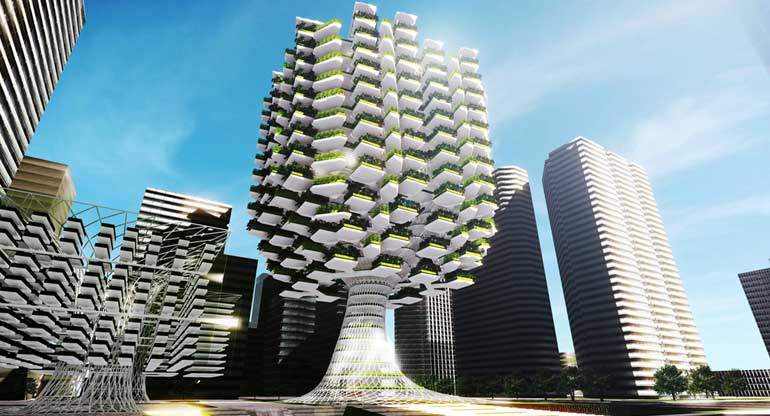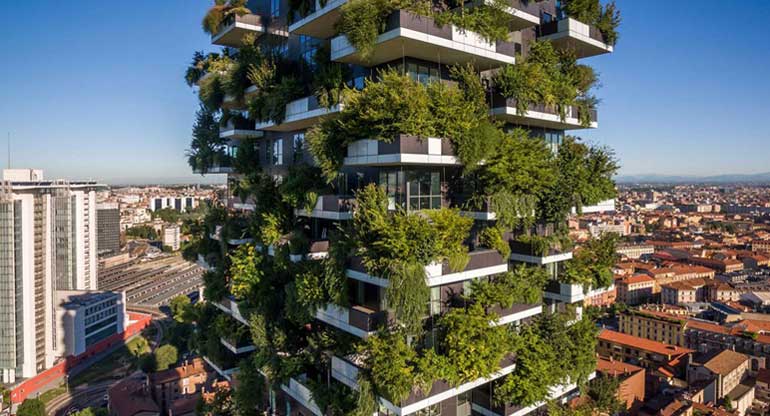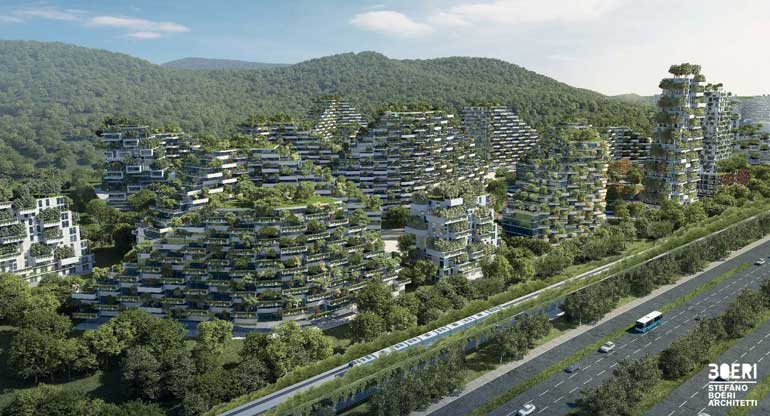We were just getting used to green roofs—those fascinating combinations of garden and architecture. But now two architects working at opposite ends of the globe are planning even more incredible feats by designing farms and forests designed to live on the face of a skyscraper.
One of the most dramatic of these new urbanized farm projects is the Urban Skyfarm currently under design by Brooklyn-based Aprilli Design Studio for a site in Seoul, South Korea. This prototype building project uses four major tree-based components—the “root,” “trunk,” “branch,” and “leaves” —to house more than 24 acres of space for growing fruit trees, tomatoes, and other sustainable vegetation. The trunk of the tree is intended to contain an indoor hydroponic farm for greens, while the root portion provides a wide environmentally controlled space for market places and public activities.

Meanwhile, turbines at the top of the tower provide enough energy to power the whole operation in a net-zero environment. The design also can capture rainwater and filter it through an artificial wetland before returning fresh water to the nearby Cheonggyecheon stream. Architects Steve Lee and See Yoon Park say the structure could support hundreds of environmental functions and serve as a model for how buildings are designed, constructed, and utilized in the future.
“Our version of the vertical farm was intended to become an independent, open-to-air structure which would be purely focusing on farming activities and sustainable functions such as generating renewable energy and performing air and water filtration,” the architects told Fast Company.
“With the support of hydroponic farming technology, the space could efficiently host more than 5,000 fruit trees. Vertical farming is more than an issue of economical feasibility, since it can provide more trees than average urban parks, helping resolve urban environmental issues such as air pollution, water run-off, and heat island effects, and bringing back balance to the urban ecology.”
Environmentally, the Urban Skyfarm acts as a living machine by producing renewable energy and lending the building improved air quality while reducing heat accumulation, storm water runoff, and carbon dioxide.
Mimicking the biological structure of a tree lends the design many structural and environmental advantages by creating a lightweight but efficient space to host different farming activities. Its designers also attest that the form creates a strong iconic image and represents a symbol of well-being and sustainable development.
Meanwhile, Back in Milan, Italy . . .
On the other side of the world, a wildly innovative Italian architect is plotting to apply greenery to the world’s most innovative buildings, including an already constructed project in Milan that has been named one of the the best tall buildings in the world.
The designer and architect is Stefano Boeri, and the dual skyscraper project in Milan is Bosco Verticale. His 256-foot and 344-foot towers are swaddled in more than 700 trees and 100 species of plants. In total, there are around 21,000 plants on the two towers, equivalent to five acres of forest spread over 1,300 square meters. It even has its own natural ecosystem with more than 20 species of birds nesting between the two towers.

The design really is “green” in more than color only. The massive amounts of plant life help reduce smog and carbon dioxide, dampen noise levels, boost oxygen, and regulate heat and cold within the twin towers. Inside, a sophisticated irrigation system redirects used water back onto the forested “porches” to sustain the plant life.
Boeri calls the concept the “Vertical Forest” design, a concept that won the firm, Stefano Boeri Architetti, second place in last year’s Emporis Skyscraper Award, beating out more than 120 competitors including One World Trade Center in New York City and Burj Mohammed Bin Rashid Tower in Abu Dhabi.
“It is a model for vertical densification of nature within the city,” Boeri says. “Vertical Forest increases biodiversity, so it becomes both a magnet for and a symbol of the spontaneous re-colonization of the city by vegetation and animal life.”
Meanwhile, Around the World . . .
Milan’s Bosco Verticale is far from Boeri’s singular vision, and is just one of a host of projects around the world that are using urbanized vegetation to make life better for the people who live and work in these buildings.
Boeri has already unveiled plans for two Vertical Forests in Nanjing, China, as well as “Liuzhou Forest City” in China, the Wonderwoods residential apartment project in the Netherlands, and the sprawling Guizhou Mountain Forest Hotel in Southern China. He also recently announced a 36-story tower in Lausanne, Switzerland, where “Tower of Cedars” will feature more than 18,000 plants and 100 trees.

“It’s something I’d been thinking about for a long time,” Boeri said recently. “I’ve always been fascinated by trees and architecture. In Lucca, Italy, there’s a 14th-century tower that has trees at the top. So I started to imagine how trees could become the main protagonist on a building’s facade.”
Boeri isn’t the only one thinking about how to build forests and gardens in the sky. His innovative, arboreal designs are inspiring and complementing other greenery-inspired architectural projects around the globe.
Rolex’s twisty future Dallas headquarters recently broke ground on its construction, featuring a design by architect Kengo Kuma that was inspired by Japanese castles and features landscaped terraces and a tree-lined rooftop event space.
Danish Architects Bjarke Ingels are hard at work in Los Angeles on 670 Mesquit, a 2.6 million-square-foot mixed-use project that features two massive concrete cubes topped with landscaped terraces.
Back in Asia, Vo Trang Nghia Architects are building a city complex in Ho Chi Minh City that will feature a 90,000-square-foot project with a communal rooftop garden. They’re also building a tree-lined campus at FPT University that will spread an elevated forest over the 14-square-mile site.
One Central Park in Sydney, Australia, hosts more than 190 plant species native to the country and features massive crawling vines that climb the building’s face.
Some critics have doubted the scientific veracity of the tree-building concepts, not to mention the aesthetics of simply propping a tree onto a concept drawing, but these innovative designers seem to be using green technology in a manner that is both ethically and tactically responsible.
Besides, some people just can’t see the forest through the trees.
Photo Credits: Stefano Boeri Architetti, Aprilli Design Studio.
 This one may be surprising because cardboard—out of which most pizza boxes are made—is practically the consummate recyclable material. But as the folks over at HGTV explain, the grease absorbed by cardboard boxes affects the process of making cardboard into new materials. So don’t let pizza boxes trip you up! Don’t mis-recycle them, throw them away and make recycling better for everyone.
This one may be surprising because cardboard—out of which most pizza boxes are made—is practically the consummate recyclable material. But as the folks over at HGTV explain, the grease absorbed by cardboard boxes affects the process of making cardboard into new materials. So don’t let pizza boxes trip you up! Don’t mis-recycle them, throw them away and make recycling better for everyone. Think it’s good to recycle plastic? You’re right! Just not this kind of plastic. According to Rebin, a sustainable design company, Saran wrap “can jam the machinery used to recycle plastic, costing time and money.” Think of where your recycled plastic wrap goes, and you’ll be much less likely to mis-recycle it.
Think it’s good to recycle plastic? You’re right! Just not this kind of plastic. According to Rebin, a sustainable design company, Saran wrap “can jam the machinery used to recycle plastic, costing time and money.” Think of where your recycled plastic wrap goes, and you’ll be much less likely to mis-recycle it. Batteries today can be thrown out with your trash because they do not have as much mercury as those before 1997, when new mandates to phase out mercury were passed. But if you come upon older batteries or feel environmentally conscious about causally tossing them out, there are various recycling options from which you can choose. Older batteries contain heavy metals, so letting them rest in landfills is a long-term environmental risk for us all. Take batteries to a local facility that’s dedicated to recycling batteries and check out Call 2 Recycle for their recycling programs.
Batteries today can be thrown out with your trash because they do not have as much mercury as those before 1997, when new mandates to phase out mercury were passed. But if you come upon older batteries or feel environmentally conscious about causally tossing them out, there are various recycling options from which you can choose. Older batteries contain heavy metals, so letting them rest in landfills is a long-term environmental risk for us all. Take batteries to a local facility that’s dedicated to recycling batteries and check out Call 2 Recycle for their recycling programs. Ever wonder how paper cups are made to hold hot beverages, but are also recyclable? Unfortunately, only one of those two things is true. Most paper cups are made out of a non-recyclable plastic. Don’t get tripped up and mis-recycle them.
Ever wonder how paper cups are made to hold hot beverages, but are also recyclable? Unfortunately, only one of those two things is true. Most paper cups are made out of a non-recyclable plastic. Don’t get tripped up and mis-recycle them. According to the pop culture site Konbini, a woman mistakenly tried to recycle an extremely rare, extremely valuable piece of tech history. This doesn’t have much to do with saving energy, but, um, don’t be like her!
According to the pop culture site Konbini, a woman mistakenly tried to recycle an extremely rare, extremely valuable piece of tech history. This doesn’t have much to do with saving energy, but, um, don’t be like her!

 Our friends at Green Builder Media
Our friends at Green Builder Media  The second big strength of The Flex House is implied by its name. Single? You can create hundreds of square feet of recreation/office space. Looking to raise kids in your Flex House? Any number of floor plans can help you optimize your family’s sanctuary. You can have upstairs space or you can keep things on one story. You can add expansion modules or keep the floor plan basic. Remarkably, a home that can be “100 percent energy self-sufficient” per Green Builder is also virtually as adaptable as any you’re likely to find.
The second big strength of The Flex House is implied by its name. Single? You can create hundreds of square feet of recreation/office space. Looking to raise kids in your Flex House? Any number of floor plans can help you optimize your family’s sanctuary. You can have upstairs space or you can keep things on one story. You can add expansion modules or keep the floor plan basic. Remarkably, a home that can be “100 percent energy self-sufficient” per Green Builder is also virtually as adaptable as any you’re likely to find. Here’s where this all starts to get ridiculous. The sizable, adaptable Flex House is not some sort of boutique home design. Amazingly, the base model will cost between $85,000 and $100,000, about the median home price in
Here’s where this all starts to get ridiculous. The sizable, adaptable Flex House is not some sort of boutique home design. Amazingly, the base model will cost between $85,000 and $100,000, about the median home price in 


 Don’t be afraid to use the used! Not everything in your dorm room has to be brand new to be stylish. Rather than heading to big department stores for décor, try checking out some second-hand stores, online “used” retailers like
Don’t be afraid to use the used! Not everything in your dorm room has to be brand new to be stylish. Rather than heading to big department stores for décor, try checking out some second-hand stores, online “used” retailers like  While most dorms don’t allow students to exceed or go below a specific degree in the dorm room’s temperature, you can take it one step further and not use the university’s air conditioning all together! Try opening a window, turn on the fan, or even take a (quick) cold shower before you hit the hay! The less air conditioning you use, the more energy you conserve!
While most dorms don’t allow students to exceed or go below a specific degree in the dorm room’s temperature, you can take it one step further and not use the university’s air conditioning all together! Try opening a window, turn on the fan, or even take a (quick) cold shower before you hit the hay! The less air conditioning you use, the more energy you conserve! It’s time to dip into your creative side. Rather than buying décor that you can’t recycle once you grow out of it or move out, try making your own! Use paper, cardboard, or even plastic so that once you don’t need it, it can be re-purposed into something else. Try making a paper lamp, or using paper wall tiles to amp-up those plain dorm walls! Items made up of recyclable matter are not only better for the environment, but can also add a unique touch to the traditional dorm room.
It’s time to dip into your creative side. Rather than buying décor that you can’t recycle once you grow out of it or move out, try making your own! Use paper, cardboard, or even plastic so that once you don’t need it, it can be re-purposed into something else. Try making a paper lamp, or using paper wall tiles to amp-up those plain dorm walls! Items made up of recyclable matter are not only better for the environment, but can also add a unique touch to the traditional dorm room. We know what you’re thinking, “too expensive!”. But, there are affordable organic products out there, it just takes a little bit of research! Besides, investing in an organic sheet/bedding set and pillow cases isn’t a bad idea. Opting for
We know what you’re thinking, “too expensive!”. But, there are affordable organic products out there, it just takes a little bit of research! Besides, investing in an organic sheet/bedding set and pillow cases isn’t a bad idea. Opting for  We know, between studying and making new friends, there isn’t much time to clean the dorm room. But, when you do, it’s best to use organic and
We know, between studying and making new friends, there isn’t much time to clean the dorm room. But, when you do, it’s best to use organic and  Lower your electricity usage with
Lower your electricity usage with